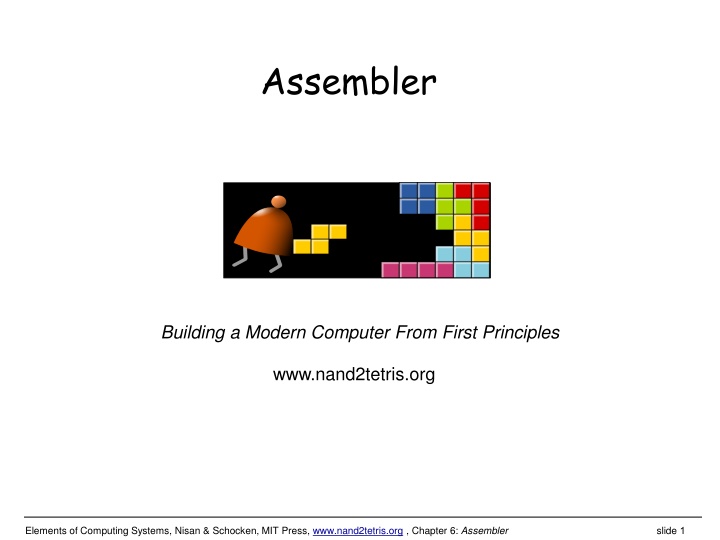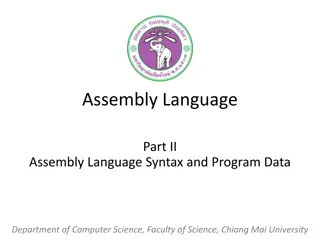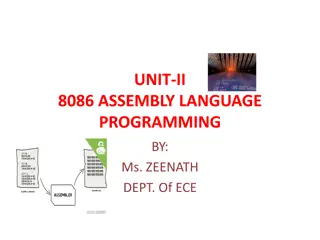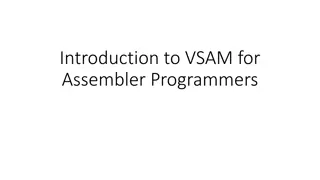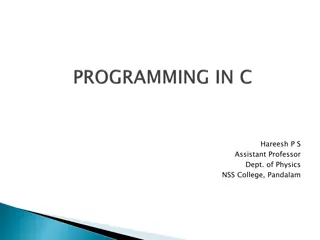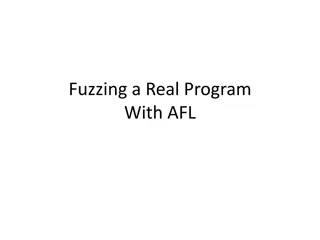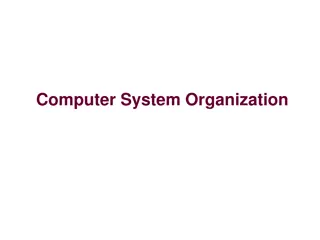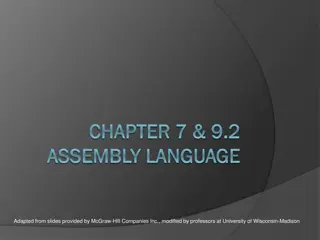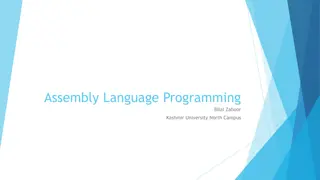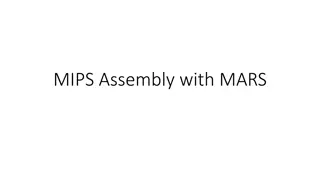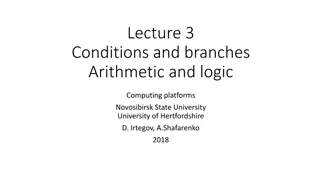Assembler
Dive into the world of assemblers in computer science with a focus on the hierarchy, programming tricks, translation challenges, and hands-on examples like target code generation and low-level programming in Hack. Explore the essence of building a computer from scratch.
Download Presentation

Please find below an Image/Link to download the presentation.
The content on the website is provided AS IS for your information and personal use only. It may not be sold, licensed, or shared on other websites without obtaining consent from the author.If you encounter any issues during the download, it is possible that the publisher has removed the file from their server.
You are allowed to download the files provided on this website for personal or commercial use, subject to the condition that they are used lawfully. All files are the property of their respective owners.
The content on the website is provided AS IS for your information and personal use only. It may not be sold, licensed, or shared on other websites without obtaining consent from the author.
E N D
Presentation Transcript
Assembler Building a Modern Computer From First Principles www.nand2tetris.org www.nand2tetris.org Elements of Computing Systems, Nisan & Schocken, MIT Press, www.nand2tetris.org , Chapter 6: Assembler slide 1
Where we are at: Abstract design Software hierarchy Human Thought abstract interface Chapters 9, 12 Compiler H.L. Language & Operating Sys. abstract interface Chapters 10 - 11 VM Translator Virtual Machine abstract interface Chapters 7 - 8 Assembly Language Assembler Chapter 6 abstract interface Computer Architecture Machine Language abstract interface Chapters 4 - 5 Gate Logic Hardware Platform abstract interface Chapters 1 - 3 Electrical Engineering Chips & Logic Gates Hardware hierarchy Physics www.nand2tetris.org Elements of Computing Systems, Nisan & Schocken, MIT Press, www.nand2tetris.org , Chapter 6: Assembler slide 2
Why care about assemblers? Assemblers employ nifty programming tricks Assemblers are the first rung up the software hierarchy ladder An assembler is a translator of a simple language Writing an assembler = low-impact practice for writing compilers. cross-platform compiling www.nand2tetris.org Elements of Computing Systems, Nisan & Schocken, MIT Press, www.nand2tetris.org , Chapter 6: Assembler slide 3
Assembly example Target code (a text file of binary Hack code) Source code (example) 0000000000010000 1110111111001000 0000000000010001 1110101010001000 0000000000010000 1111110000010000 0000000000000000 1111010011010000 0000000000010010 1110001100000001 0000000000010000 1111110000010000 0000000000010001 ... // Computes 1+...+RAM[0] // And stored the sum in RAM[1] @i M=1 // i = 1 @sum M=0 // sum = 0 (LOOP) @i // if i>RAM[0] goto WRITE D=M @R0 D=D-M @WRITE D;JGT ... // Etc. assemble execute The program translation challenge Extract the program s semantics from the source program, using the syntax rules of the source language Re-express the program s semantics in the target language, using the syntax rules of the target language Assembler = simple translator Translates each assembly command into one or more binary machine instructions Handles symbols (e.g. i, sum, LOOP, ). www.nand2tetris.org Elements of Computing Systems, Nisan & Schocken, MIT Press, www.nand2tetris.org , Chapter 6: Assembler slide 4
Revisiting Hack low-level programming: an example Assembly program (sum.asm) CPU emulator screen shot after running this program // Computes 1+...+RAM[0] // And stores the sum in RAM[1]. @i M=1 // i = 1 @sum M=0 // sum = 0 (LOOP) @i // if i>RAM[0] goto WRITE D=M @R0 D=D-M @WRITE D;JGT @i // sum += i D=M @sum M=D+M @i // i++ M=M+1 @LOOP // goto LOOP 0;JMP (WRITE) @sum D=M @R1 M=D // RAM[1] = the sum (END) @END 0;JMP user supplied input program generated output The CPU emulator allows loading and executing symbolic Hack code. It resolves all the symbolic symbols to memory locations, and executes the code. www.nand2tetris.org Elements of Computing Systems, Nisan & Schocken, MIT Press, www.nand2tetris.org , Chapter 6: Assembler slide 5
The assemblers view of an assembly program Assembly program // Computes 1+...+RAM[0] // And stores the sum in RAM[1]. @i M=1 // i = 1 @sum M=0 // sum = 0 (LOOP) @i // if i>RAM[0] goto WRITE D=M @R0 D=D-M @WRITE D;JGT @i // sum += i D=M @sum M=D+M @i // i++ M=M+1 @LOOP // goto LOOP 0;JMP (WRITE) @sum D=M @R1 M=D // RAM[1] = the sum (END) @END 0;JMP Assembly program = a stream of text lines, each being one of the following: www.nand2tetris.org Elements of Computing Systems, Nisan & Schocken, MIT Press, www.nand2tetris.org , Chapter 6: Assembler slide 6
The assemblers view of an assembly program Assembly program // Computes 1+...+RAM[0] // And stores the sum in RAM[1]. @i M=1 // i = 1 @sum M=0 // sum = 0 (LOOP) @i // if i>RAM[0] goto WRITE D=M @R0 D=D-M @WRITE D;JGT @i // sum += i D=M @sum M=D+M @i // i++ M=M+1 @LOOP // goto LOOP 0;JMP (WRITE) @sum D=M @R1 M=D // RAM[1] = the sum (END) @END 0;JMP Assembly program = a stream of text lines, each being one of the following: White space Empty lines/indentation Line comments In-line comments www.nand2tetris.org Elements of Computing Systems, Nisan & Schocken, MIT Press, www.nand2tetris.org , Chapter 6: Assembler slide 7
The assemblers view of an assembly program Assembly program // Computes 1+...+RAM[0] // And stores the sum in RAM[1]. @i M=1 // i = 1 @sum M=0 // sum = 0 (LOOP) @i // if i>RAM[0] goto WRITE D=M @R0 D=D-M @WRITE D;JGT @i // sum += i D=M @sum M=D+M @i // i++ M=M+1 @LOOP // goto LOOP 0;JMP (WRITE) @sum D=M @R1 M=D // RAM[1] = the sum (END) @END 0;JMP Assembly program = a stream of text lines, each being one of the following: White space Empty lines/indentation Line comments In-line comments Instructions A-instruction C-instruction www.nand2tetris.org Elements of Computing Systems, Nisan & Schocken, MIT Press, www.nand2tetris.org , Chapter 6: Assembler slide 8
The assemblers view of an assembly program Assembly program // Computes 1+...+RAM[0] // And stores the sum in RAM[1]. @i M=1 // i = 1 @sum M=0 // sum = 0 (LOOP) @i // if i>RAM[0] goto WRITE D=M @R0 D=D-M @WRITE D;JGT @i // sum += i D=M @sum M=D+M @i // i++ M=M+1 @LOOP // goto LOOP 0;JMP (WRITE) @sum D=M @R1 M=D // RAM[1] = the sum (END) @END 0;JMP Assembly program = a stream of text lines, each being one of the following: White space Empty lines/indentation Line comments In-line comments Instructions A-instruction C-instruction Symbols references Label declaration (XXX) www.nand2tetris.org Elements of Computing Systems, Nisan & Schocken, MIT Press, www.nand2tetris.org , Chapter 6: Assembler slide 9
The assemblers view of an assembly program Assembly program // Computes 1+...+RAM[0] // And stores the sum in RAM[1]. @16 M=1 // i = 1 @17 M=0 // sum = 0 Assembly program = a stream of text lines, each being one of the following: 0 1 2 3 White space Empty lines/indentation Line comments In-line comments @16 D=M @0 D=D-M @18 D;JGT @16 D=M @17 M=D+M @16 M=M+1 @4 // goto LOOP 0;JMP // if i>RAM[0] goto WRITE 4 5 6 7 8 9 Instructions A-instruction C-instruction // sum += i 10 11 12 13 14 15 16 17 // i++ Symbols references Label declaration (XXX) @17 D=M @1 M=D // RAM[1] = the sum 18 19 20 21 Assume that there is no symbol for now! @22 0;JMP 22 23 www.nand2tetris.org Elements of Computing Systems, Nisan & Schocken, MIT Press, www.nand2tetris.org , Chapter 6: Assembler slide 10
White space Assembly program // Computes 1+...+RAM[0] // And stores the sum in RAM[1]. @16 M=1 // i = 1 @17 M=0 // sum = 0 Assembly program = a stream of text lines, each being one of the following: White space Empty lines/indentation Line comments In-line comments @16 // if i>RAM[0] goto WRITE D=M @0 D=D-M @18 D;JGT @16 // sum += i D=M @17 M=D+M @16 // i++ M=M+1 @4 // goto LOOP 0;JMP Instructions A-instruction C-instruction Symbols references Label declaration (XXX) @17 D=M @1 M=D // RAM[1] = the sum @22 0;JMP www.nand2tetris.org Elements of Computing Systems, Nisan & Schocken, MIT Press, www.nand2tetris.org , Chapter 6: Assembler slide 11
White space ignore/remove them Assembly program @16 M=1 @17 M=0 @16 D=M @0 D=D-M @18 D;JGT @16 D=M @17 M=D+M @16 M=M+1 @4 0;JMP @17 D=M @1 M=D @22 0;JMP Assembly program = a stream of text lines, each being one of the following: White space Empty lines/indentation Line comments In-line comments Instructions A-instruction C-instruction Symbols references Label declaration (XXX) www.nand2tetris.org Elements of Computing Systems, Nisan & Schocken, MIT Press, www.nand2tetris.org , Chapter 6: Assembler slide 12
Instructions binary encoding Assembly program @16 M=1 @17 M=0 @16 D=M @0 D=D-M @18 D;JGT @16 D=M @17 M=D+M @16 M=M+1 @4 0;JMP @17 D=M @1 M=D @22 0;JMP Assembly program = a stream of text lines, each being one of the following: White space Empty lines/indentation Line comments In-line comments Instructions A-instruction C-instruction Symbols references Label declaration (XXX) www.nand2tetris.org Elements of Computing Systems, Nisan & Schocken, MIT Press, www.nand2tetris.org , Chapter 6: Assembler slide 13
Translating / assembling A-instructions @value // Where value is either a non-negative decimal number // or a symbol referring to such number. Symbolic: value (v = 0 or 1) v v v v v v v v v v v v v v v 0 Binary: Translation to binary: If value is a non-negative decimal number, simple, e.g. @16 If value is a symbol, later. www.nand2tetris.org Elements of Computing Systems, Nisan & Schocken, MIT Press, www.nand2tetris.org , Chapter 6: Assembler slide 14
Translating / assembling C-instructions Symbolic: dest=comp;jump// Either the dest or jump fields may be empty. // If dest is empty, the "=" is ommitted; // If jump is empty, the ";" is omitted. comp dest jump 1 1 1 Binary: a c1 c2 c3 c4 c5 c6 d1 d2 d3 j1 j2 j3 www.nand2tetris.org Elements of Computing Systems, Nisan & Schocken, MIT Press, www.nand2tetris.org , Chapter 6: Assembler slide 15
Translating / assembling C-instructions Symbolic: dest=comp;jump// Either the dest or jump fields may be empty. // If dest is empty, the "=" is ommitted; // If jump is empty, the ";" is omitted. Example: MD=D+1 comp dest jump 1 1 1 Binary: a c1 c2 c3 c4 c5 c6 d1 d2 d3 j1 j2 j3 www.nand2tetris.org Elements of Computing Systems, Nisan & Schocken, MIT Press, www.nand2tetris.org , Chapter 6: Assembler slide 16
Translating / assembling C-instructions Symbolic: dest=comp;jump// Either the dest or jump fields may be empty. // If dest is empty, the "=" is ommitted; // If jump is empty, the ";" is omitted. Example: D; JGT comp dest jump 1 1 1 Binary: a c1 c2 c3 c4 c5 c6 d1 d2 d3 j1 j2 j3 www.nand2tetris.org Elements of Computing Systems, Nisan & Schocken, MIT Press, www.nand2tetris.org , Chapter 6: Assembler slide 17
The overall assembly logic Assembly program For each (real) command // Computes 1+...+RAM[0] // And stores the sum in RAM[1]. @i M=1 // i = 1 @sum M=0 // sum = 0 (LOOP) @i // if i>RAM[0] goto WRITE D=M @0 D=D-M @WRITE D;JGT @i // sum += i D=M @sum M=D+M @i // i++ M=M+1 @LOOP // goto LOOP 0;JMP (WRITE) @sum D=M @1 M=D // RAM[1] = the sum (END) @END 0;JMP Parse the command, i.e. break it into its underlying fields A-instruction: replace the symbolic reference (if any) with the corresponding memory address, which is a number (how to do it, later) C-instruction: for each field in the instruction, generate the corresponding binary code Assemble the translated binary codes into a complete 16-bit machine instruction Write the 16-bit instruction to the output file. www.nand2tetris.org Elements of Computing Systems, Nisan & Schocken, MIT Press, www.nand2tetris.org , Chapter 6: Assembler slide 18
Typical symbolic Hack assembly code: Handling symbols (aka symbol resolution) @R0 D=M @END D;JLE @counter M=D @SCREEN D=A @x M=D Assembly programs typically have many symbols: Labels that mark destinations of goto commands Labels that mark special memory locations Variables (LOOP) @x A=M M=-1 @x D=M @32 D=D+A @x M=D @counter MD=M-1 @LOOP D;JGT These symbols fall into two categories: User defined symbols (created by programmers) Variables Labels (forward reference could be a problem) Pre-defined symbols (used by the Hack platform). (END) @END 0;JMP www.nand2tetris.org Elements of Computing Systems, Nisan & Schocken, MIT Press, www.nand2tetris.org , Chapter 6: Assembler slide 19
Typical symbolic Hack assembly code: Handling symbols: user-defined symbols @R0 D=M @END D;JLE @counter M=D @SCREEN D=A @x M=D Label symbols: Used to label destinations of goto commands. Declared by the pseudo-command (XXX). This directive defines the symbol XXX to refer to the instruction memory location holding the next command in the program. (the assembler needs to maintain instrCtr) Variable symbols: Any user-defined symbol xxx appearing in an assembly program that is not defined elsewhere using the (xxx) directive is treated as a variable, and is automatically assigned a unique RAM address, starting at RAM address 16 (the assembler needs to maintain nextAddr) (LOOP) @x A=M M=-1 @x D=M @32 D=D+A @x M=D @counter MD=M-1 @LOOP D;JGT (why start at 16? Later.) By convention, Hack programmers use lower-case and upper-case to represent variable and label names, respectively (END) @END 0;JMP www.nand2tetris.org Elements of Computing Systems, Nisan & Schocken, MIT Press, www.nand2tetris.org , Chapter 6: Assembler slide 20
Typical symbolic Hack assembly code: Handling symbols: pre-defined symbols @R0 D=M @END D;JLE @counter M=D @SCREEN D=A @x M=D Virtual registers: The symbols R0, , R15 are automatically predefined to refer to RAM addresses 0, ,15 I/O pointers: The symbols SCREEN and KBD are automatically predefined to refer to RAM addresses 16384 and 24576, respectively (base addresses of the screen and keyboard memory maps) VM control pointers: the symbols SP, LCL, ARG, THIS, and THAT (that don t appear in the code example on the right) are automatically predefined to refer to RAM addresses 0 to 4, respectively (The VM control pointers, which overlap R0, , R4 will come to play in the virtual machine implementation, covered in the next lecture) (LOOP) @x A=M M=-1 @x D=M @32 D=D+A @x M=D @counter MD=M-1 @LOOP D;JGT (END) @END 0;JMP www.nand2tetris.org Elements of Computing Systems, Nisan & Schocken, MIT Press, www.nand2tetris.org , Chapter 6: Assembler slide 21
Handling symbols: symbol table Source code (example) Symbol table R0 0 R1 1 R2 2 ... ... R15 15 SCREEN 16384 KBD 24576 SP 0 LCL 1 ARG 2 THIS 3 THAT 4 LOOP 4 WRITE 18 END 22 i sum 17 // Computes 1+...+RAM[0] // And stored the sum in RAM[1] @i M=1 // i = 1 @sum M=0 // sum = 0 (LOOP) @i // if i>RAM[0] goto WRITE D=M @R0 D=D-M @WRITE D;JGT @i // sum += i D=M @sum M=D+M @i // i++ M=M+1 @LOOP // goto LOOP 0;JMP (WRITE) @sum D=M @R1 M=D // RAM[1] = the sum (END) @END 0;JMP 16 This symbol table is generated by the assembler, and used to translate the symbolic code into binary code. www.nand2tetris.org Elements of Computing Systems, Nisan & Schocken, MIT Press, www.nand2tetris.org , Chapter 6: Assembler slide 22
Handling symbols: constructing the symbol table Source code (example) Symbol table R0 0 R1 1 R2 2 ... R15 15 SCREEN 16384 KBD 24576 SP 0 LCL 1 ARG 2 THIS 3 THAT 4 // Computes 1+...+RAM[0] // And stored the sum in RAM[1] @i M=1 // i = 1 @sum M=0 // sum = 0 (LOOP) @i // if i>RAM[0] goto WRITE D=M @R0 D=D-M @WRITE D;JGT @i // sum += i D=M @sum M=D+M @i // i++ M=M+1 @LOOP // goto LOOP 0;JMP (WRITE) @sum D=M @R1 M=D // RAM[1] = the sum (END) @END 0;JMP Initialization: create an empty symbol table and populate it with all the pre-defined symbols www.nand2tetris.org Elements of Computing Systems, Nisan & Schocken, MIT Press, www.nand2tetris.org , Chapter 6: Assembler slide 23
Handling symbols: constructing the symbol table Source code (example) Symbol table R0 0 R1 1 R2 2 ... R15 15 SCREEN 16384 KBD 24576 SP 0 LCL 1 ARG 2 THIS 3 THAT 4 LOOP 4 WRITE 18 END 22 // Computes 1+...+RAM[0] // And stored the sum in RAM[1] @i M=1 // i = 1 @sum M=0 // sum = 0 (LOOP) @i // if i>RAM[0] goto WRITE D=M @R0 D=D-M @WRITE D;JGT @i // sum += i D=M @sum M=D+M @i // i++ M=M+1 @LOOP // goto LOOP 0;JMP (WRITE) @sum D=M @R1 M=D // RAM[1] = the sum (END) @END 0;JMP Initialization: create an empty symbol table and populate it with all the pre-defined symbols First pass: go through the entire source code, and add all the user-defined label symbols to the symbol table (without generating any code) www.nand2tetris.org Elements of Computing Systems, Nisan & Schocken, MIT Press, www.nand2tetris.org , Chapter 6: Assembler slide 24
Handling symbols: constructing the symbol table Source code (example) Symbol table R0 0 R1 1 R2 2 ... R15 15 SCREEN 16384 KBD 24576 SP 0 LCL 1 ARG 2 THIS 3 THAT 4 LOOP 4 WRITE 18 END 22 i sum 17 // Computes 1+...+RAM[0] // And stored the sum in RAM[1] @i M=1 // i = 1 @sum M=0 // sum = 0 (LOOP) @i // if i>RAM[0] goto WRITE D=M @R0 D=D-M @WRITE D;JGT @i // sum += i D=M @sum M=D+M @i // i++ M=M+1 @LOOP // goto LOOP 0;JMP (WRITE) @sum D=M @R1 M=D // RAM[1] = the sum (END) @END 0;JMP 16 Initialization: create an empty symbol table and populate it with all the pre-defined symbols First pass: go through the entire source code, and add all the user-defined label symbols to the symbol table (without generating any code) Second pass: go again through the source code, and use the symbol table to translate all the commands. In the process, handle all the user- defined variable symbols. www.nand2tetris.org Elements of Computing Systems, Nisan & Schocken, MIT Press, www.nand2tetris.org , Chapter 6: Assembler slide 25
Handling symbols: constructing the symbol table (one-pass solution?) Source code (example) Symbol table R0 0 R1 1 R2 2 ... R15 15 SCREEN 16384 KBD 24576 SP 0 LCL 1 ARG 2 THIS 3 THAT 4 // Computes 1+...+RAM[0] // And stored the sum in RAM[1] @i M=1 // i = 1 @sum M=0 // sum = 0 (LOOP) @i // if i>RAM[0] goto WRITE D=M @R0 D=D-M @WRITE D;JGT @i // sum += i D=M @sum M=D+M @i // i++ M=M+1 @LOOP // goto LOOP 0;JMP (WRITE) @sum D=M @R1 M=D // RAM[1] = the sum (END) @END 0;JMP www.nand2tetris.org Elements of Computing Systems, Nisan & Schocken, MIT Press, www.nand2tetris.org , Chapter 6: Assembler slide 26
The assembly process (detailed) Initialization: create the symbol table and initialize it with the pre- defined symbols First pass: march through the source code without generating any code. For each label declaration (LABEL) that appears in the source code, add the pair <LABEL , n > to the symbol table www.nand2tetris.org Elements of Computing Systems, Nisan & Schocken, MIT Press, www.nand2tetris.org , Chapter 6: Assembler slide 27
The assembly process (detailed) Second pass: march again through the source, and process each line: If the line is a C-instruction, simple If the line is @xxx where xxx is a number, simple If the line is @xxx and xxx is a symbol, look it up in the symbol table and proceed as follows: If the symbol is found, replace it with its numeric value and complete the command s translation If the symbol is not found, then it must represent a new variable: add the pair <xxx , n > to the symbol table, where n is the next available RAM address, and complete the command s translation. (Platform design decision: the allocated RAM addresses are running, starting at address 16). www.nand2tetris.org Elements of Computing Systems, Nisan & Schocken, MIT Press, www.nand2tetris.org , Chapter 6: Assembler slide 28
The result ... Source code (example) Target code // Computes 1+...+RAM[0] // And stored the sum in RAM[1] @i M=1 // i = 1 @sum M=0 // sum = 0 (LOOP) @i // if i>RAM[0] goto WRITE D=M @R0 D=D-M @WRITE D;JGT @i // sum += i D=M @sum M=D+M @i // i++ M=M+1 @LOOP // goto LOOP 0;JMP (WRITE) @sum D=M @R1 M=D // RAM[1] = the sum (END) @END 0;JMP 0000000000010000 1110111111001000 0000000000010001 1110101010001000 0000000000010000 1111110000010000 0000000000000000 1111010011010000 0000000000010010 1110001100000001 0000000000010000 1111110000010000 0000000000010001 1111000010001000 0000000000010000 1111110111001000 0000000000000100 1110101010000111 0000000000010001 1111110000010000 0000000000000001 1110001100001000 0000000000010110 1110101010000111 assemble Note that comment lines and pseudo-commands (label declarations) generate no code. www.nand2tetris.org Elements of Computing Systems, Nisan & Schocken, MIT Press, www.nand2tetris.org , Chapter 6: Assembler slide 29
Proposed assembler implementation An assembler program can be written in any high-level language. (and could be run in the other platforms, cross-platform compiling) The book proposes a language-independent design, as follows. Software modules: Parser: Unpacks each command into its underlying fields Code: Translates each field into its corresponding binary value, and assembles the resulting values SymbolTable: Manages the symbol table Main: Initializes I/O files and drives the show. www.nand2tetris.org Elements of Computing Systems, Nisan & Schocken, MIT Press, www.nand2tetris.org , Chapter 6: Assembler slide 30
Perspective Simple machine language, simple assembler Most assemblers are not stand-alone, but rather encapsulated in a translator of a higher order C programmers that understand the code generated by a C compiler can improve their code considerably C programming (e.g. for real-time systems) may involve re-writing critical segments in assembly, for optimization Writing an assembler is an excellent practice for writing more challenging translators, e.g. a VM Translator and a compiler, as we will do in the next lectures. www.nand2tetris.org Elements of Computing Systems, Nisan & Schocken, MIT Press, www.nand2tetris.org , Chapter 6: Assembler slide 31
